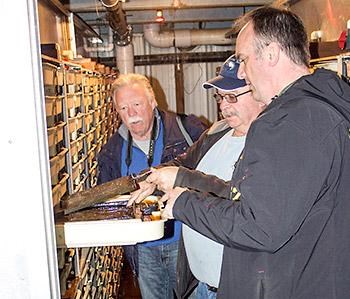Powell River Salmon Society was awarded two grants in April to support ongoing project development at its four area facilities. A grant totalling $75,000 was awarded by Pacific Salmon Foundation, and an additional sum of $2,000 issued by Pacific Western Brewing (PWB).
The infusion of cash comes at a time the society is seeing growth in community awareness and an increase in the numbers of salmon released each year.
The $2,000 donation is from PWB’s salmon stewardship grant. Every year as part of its community outreach program, the brewery awards money to wild fish hatcheries on the BC Coast that are having an affect on stream rehabilitation, improving wild salmon stocks and educating the community.
The foundation is the largest chinook-producing, volunteer-driven facility on the BC coast. It has been stocking area rivers with millions of chinook, chum and coho for more than 20 years. It was created in 1987 as an independent, non-government, charitable organization to protect, conserve and rebuild Pacific salmon populations in BC and Yukon.
Powell River Salmon Society president George Illes explained how the influx of money will aid the society. “We receive money from the DFO annually,” he said. “The remainder of our operating budget comes from corporate and private donations, many of them local.” Funds are raised in part through the society’s annual fundraising dinner and auction. Over the years, the annual dinner has generated more than $265,000 to benefit 17 projects in local streams.
Illes, a former millwright and tradesman, is a 15-year veteran of the organization.
After managing and facilitating project development and turnkey operations in developing countries worldwide, Illes decided he would return to Canada and catch up on emerging technology. He took a job at the mill, which was then owned by MacMillan Bloedel, where he was involved in the finishing stages of mill construction.
“Being a supervisor at the mill for 20-odd years taught me that if nothing else, you don’t want any surprises,” he said. “You need to always keep a half a step ahead to avoid problems that can cut into your bottom line.”
Illes said the salmon society has seen steady growth over the years. “What we’ve really done differently to improve our operations is to grow the way we look at things, how we do things and what results we’re getting. It used to be that we’d basically make sure we’d handle the eggs right, make sure we get the fish to the river. There was no education component. There was no public awareness.” Illes said there was little awareness of the society and no one on the board was doing anything about it. “There was more known about the Sliammon [Fish] Hatchery, and we’re 10 times the size,” he said. “We’ve supplied them with a lot of stuff in years gone by. It was then we realized that if we want to grow, we’ve got to let everybody know we’re here.”
The organization trained five people in stream restoration and habitat preservation and brought in new directors.
Today the society stocks approximately 1.3 million chinook to local rivers every year. Annual returns have been steadily increasing and, Illes said, they often know better than DFO how many spawners are returning to the rivers here.
“The DFO doesn’t have the funds to put people in the field and do the research and have hands on,” he said. “The reason is that there’s no money in the fisheries budget. We take up where they leave off.”
The salmon society operates four salmon enhancement facilities in the region. Duck Lake hatchery, located 10 kilometres from Lang Creek estuary, is used for egg incubation and rearing in the spring.
The mill hatchery is located at Catalyst Paper Corporation Powell River division. Facilities at the mill provide a unique opportunity to accelerate incubation. With water taken from Powell Lake, the hatchery isn’t subjected to flooding issues that affect hatcheries located on river systems.
A facility on two acres at the mouth of Lang Creek is used for stock assessment, collection of brood stock, egg collection and community education. Net pens are used on Duck Lake to facilitate the rearing and imprinting of chinook on the Lang Creek Watershed.
There are 13 area school programs that the salmon society has in place. “We bring eggs and eyed eggs to the schools and the kids raise and release the fish into the river,” said Illes. “The society has a large portable fish tank that we bring around and use to help educate the community. The Royal Bank donates $5,000 annually to help support the initiative.”



